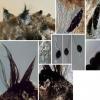
21-12-2025 09:32
Hello.A tiny ascomycete found embedded in wood in

20-12-2025 23:08
Patrice TANCHAUDBonsoir, récolte sur sol sablonneux dans l'arri�

20-12-2025 15:47
Mirek GrycHi.These grew on pine wood that was heavily covere

18-12-2025 21:17
Pol DebaenstThe identification took me to Byssonectria deformi

15-12-2025 07:09
 Danny Newman
Danny Newman
indet. Rutstroemiaceae sp. on unk. fallen leavesMc

19-12-2025 10:10
Patrice TANCHAUDBonjour, récolte réalisée en milieu dunaire, a

18-12-2025 17:23
 Bruno Coué
Bruno Coué
Bonjour,je serais heureux d'avoir votre avis sur c

18-12-2025 18:07
Margot en Geert VullingsThese plumes were found on rotten wood.They strong
 This is yet another Podospora which has developed on a collection of rabbit dung (along with P. (Schizothecium) tetraspora, P. fimiseda and P. pleiospora).
This is yet another Podospora which has developed on a collection of rabbit dung (along with P. (Schizothecium) tetraspora, P. fimiseda and P. pleiospora).It seems to sit uncomfortably between P. setosa and P. curvicolla.
For the former are characters like the shape of the asci (clavate, not saccate), no asci with 256 spores and the gelatinous appendages which are persistent on the mature spores and do not disappear in water mounts.
But the spores seem small for P. setosa and would fit better in P. curvicolla - they measure 16.4-17.3 x 10.4-11.7µm; also in some cases the hairs could be considered 'agglutinated'. I know there are ASCOFrance members with lots of experience of these coprophiles, and would again be grateful for assistance.
Cordialement
Chris

It is sometimes difficult to separate these two species, but the size of the spores and "agglutined" hairs closer to curvicolla.
It is important to measure a large number of spores to have a mean, especially since it is sometimes difficult to count the number of spores within the ascus. I also picked up some copies of P.curvicolla with little hairs "agglutined".
Michel.

